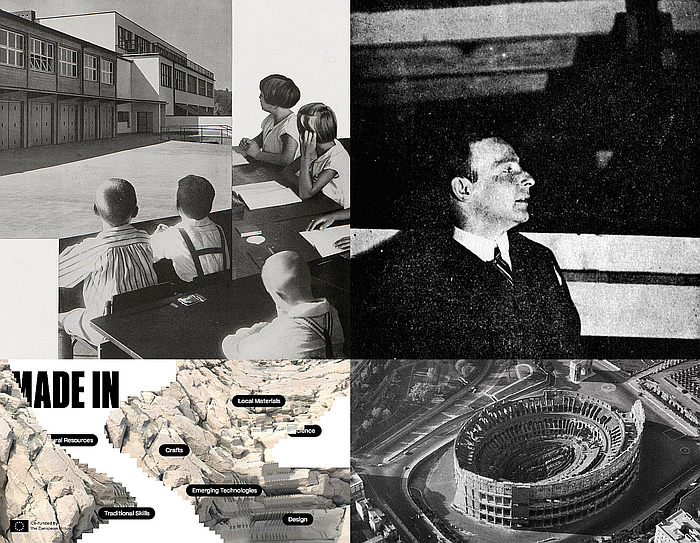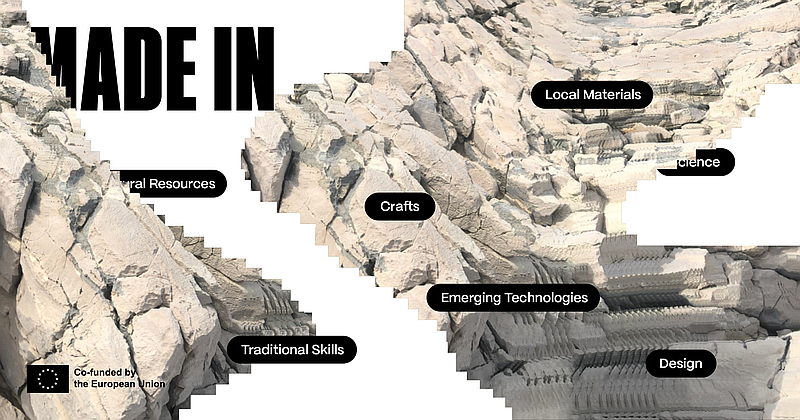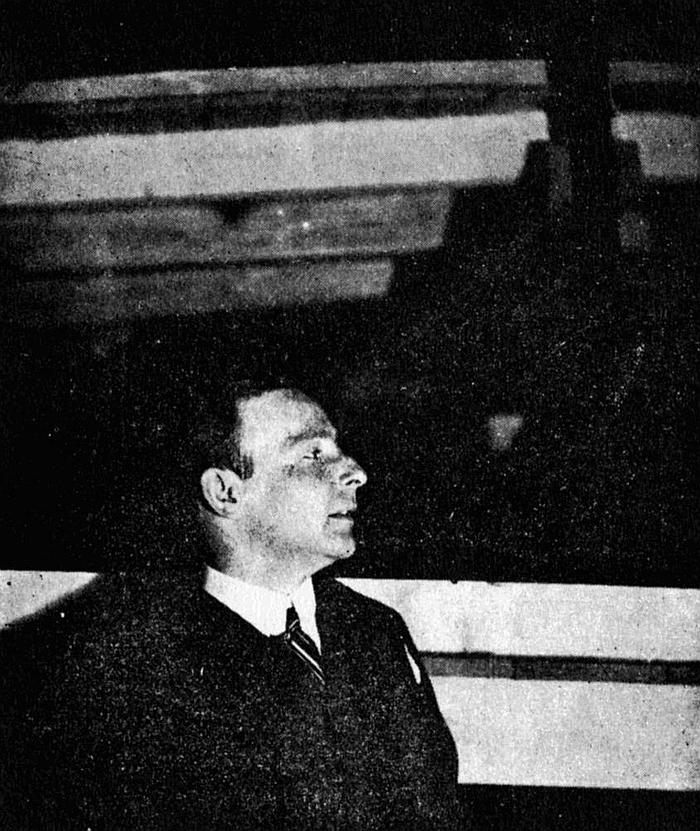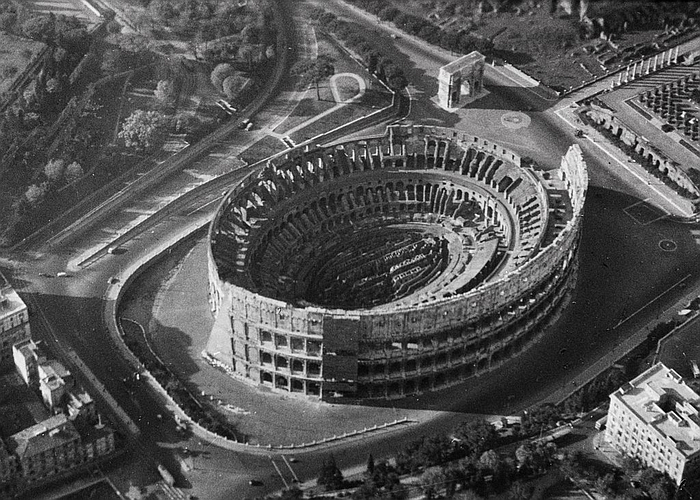As Heinrich Heine so very, very nearly wrote in 1827,
May is here with its golden lights, And silky breezes and spiced scents, And it beckons with a friendly plenitude of new architecture and design exhibitions.1
Our recommendations from the plenitude opening amidst the golden lights, silky breezes and spiced scents of May 2025 can be found in Frankfurt, Ljubljana, Vienna, Rome and Amberg.......

Formally initiated in 1925 the Neues Frankfurt project is not only one of the more interesting but one of the more informative Functionalist Modernist projects of the 1920s and 30s; a project that not only concerned itself with architecture, design, interior design and urban planning, but also with aspects of graphic design, typography, art, mobility, clothing, and questions of how a society develops within a city, how a city develops around a society, and that all against the political, economic and demographic challenges of 1920s Europe. Yet a project that today is all too often reduced to a kitchen.
By way of celebrating the centenary of the project's initiation, and stimulating reflections and discussions on what was undertaken, why and what remains, a programme of events are planned in the course of 2025 across Frankfurt, including a couplet of exhibitions opening simultaneously in the Museum Angewandte Kunst: What was the New Frankfurt? Key Questions about the 1920s Urban Planning Program, which, as the title implies, aims to provide an overview of, and introduction to, Neues Frankfurt, to be a starting point for your own investigations and Yes, we care. The New Frankfurt and the Pursuit of the Common Good with its focus on the myriad social projects realised under the Neues Frankfurt banner including, and amongst others, kindergärten, health facilities, retirement homes, public sport facilities, libraries and similar key components of any city, if components that all to often are considered after the houses, factories, shops and car parks of the city. Are considered by planners and and architects as cumbersome add-ons. But which in Frankfurt were central to the planning. And, importantly, central to the concept upon which the planning was based.
Promising a presentation of archive objects, texts, photographs, film, et al by way of allowing one to approach the numerous projects realised by Ernst May and his team, Yes, we care will also seek to link the then to the now with the hope of stimulating discussions on the contemporary state of the Common Good, contemporary definitions of Common Good, as reflected in and by our contemporary cities and questions of what we can, should, must we do to make our cities responsive, responsible social environments, and what we can learn from those who reflected on such before us.
Yes, we care. The New Frankfurt and the Pursuit of the Common Good is scheduled to open at Museum Angewandte Kunst, Schaumainkai 17, 60594 Frankfurt on Friday May 9th and run until Sunday January 11th. Further details can be found at www.museumangewandtekunst.de

Initiated in 2023 by a decuple of European institutions including the likes of, for example, Drugo More from Croatia, Portugal's Passa Ao Futuro, the Kunstgewerbemuseum, Dresden, Germany and Slovenia's MAO, the platform MADE IN sought, and seeks, to approach questions of the future of traditional craft, and by extrapolation contemporary design, via interdisciplinary research involving crafters, designers, scientists, artists, theoreticians, et al.
A platform that since 2023 has staged various conferences, events, summer schools and exhibitions by a variety of partners; a platform for all that it will invariably continue in a variety of forms, presents as its formal final exhibition Future Legacies.
An exhibition, a culmination, that promises to bring together the results of the research undertaken since 2023 in a presentation featuring a mix of installations, objects, materials, documentation, etc, that as a discursive whole seeks to explore questions of materials, processes, practices, etc, past, present and future, and which in doing so and being such should not only provide insights into what was undertaken in the course of MADE IN, and why, but also through the variety of positions and projects presented should allow for a more nuanced questioning of what is craft, why is craft, the relationships between craft and society past, present and future. And by extrapolation an analogous questioning of design. And of society.
Future Legacies is scheduled to open at the Museum of Architecture and Design, MAO, Grad Fužine, Rusjanov trg 7, 1000 Ljubljana on Thursday May 15th and run until Sunday September 14th. Further details can be found at https://mao.si

Born in Chernivtsi, then Austro-Hungary, today Ukraine, in 1890, Frederick Kiesler first made a name for himself in 1920s Europe as an avant-garde stage designer, exhibition designer and architect before becoming a leading protagonist in the development of avant-garde art, design, architecture and interior design positions in the USA of the 1930s. A creative who for all that his legacy is as endless as many of his projects are and were, and his thinking is and was, is criminally little known today.
With The Endless Search the Österreichische Friedrich und Lillian Kiesler Privatstiftung, those curators of Kiesler's archive, promise a presentation that aims to explore Kiesler, his work, his positions, his questioning, and thereby allow one to better approach his work and his legacy, via selected projects from his wide oeuvre, from across the endless time and geography and genres of his oeuvre, complimented by contemporaneous works by his friends and collaborators.
A presentation that should not only provide for an introduction to Frederick Kiesler for all those unfamiliar with him and his work, but also through allowing Kiesler to become more visible on the helix of creative (hi)story help explain the heterogeneity of the creative avant-gardes of the 1920s and 30s. An endless heterogeneity that, as with Kiesler, is only rarely seen today.
Frederick Kiesler. The Endless Search is scheduled to open at the Österreichische Friedrich und Lillian Kiesler Privatstiftung, Mariahilfer Straße 1b/Top 1, 1060 Vienna on Tuesday May 27th and run until Friday November 14th. Further details can be found at www.kiesler.org

Rome is famous for a great many things, amongst which one must count its Stadi: both those of the ancient past, including the Colosseum, and more contemporary incarnations such as the Stadio Olimpico. Stadi which despite the centuries that lie between their construction are very much linked by the lives that have been lived within them, the identifications, collective and individual, that are made with them, or their impact on the local environment, amongst a great many other aspects.
Common bonds across time and geography that Stadi aims to explore, analyse and, perhaps, deconstruct, put in perspective, via a presentation of some 54 global stadia... which? We no know, MAXXI, Rome, being one of those great many museums globally that prefers not to talk about their exhibitions in advance of the opening, perhaps for fear that people may take interest in them and, heaven forbid, visit.
But 54 Stadi we are certain will have been carefully selected; and 54 Stadi that through the discussion the curators promise to extend beyond the architectural via which Stadi are primarily approached into the social, anthropological, economic, political, et al, should allow for more nuanced appreciations of Stadi and their place not just in human society, but of their contribution to the development of human society, the urban spaces human societies occupy and the cultural spaces human societies occupy.
Stadi. Architecture of a Myth is scheduled to open at Museo nazionale delle arti del XXI secolo, MAXXI, Via Guido Reni, 4 A, Rome on Friday May 30th and run until Sunday October 26th. Further details can be found at www.maxxi.art

Amongst all the novel theory of the avant-garde, Radical, architecture of the 1960s, there was also the occasional physical, tangible, practical development, including a fascination, almost obsession, with inflatables, with pneumatic architecture, a genre in which a wide variety of protagonists worked at a variety of scales. A pneumatic architecture, a Luftarchitektur, a construction with air, that despite the numerous novel possibilities it brings with it, the advantages vis-à-vis more conventional construction in conventional contexts it self-confidently claims for itself, and the fundamental questions it poses about relationships between humans and architecture in an age that is becoming ever more transient, fugitive, that is no longer for the eternity it once was, has largely remained trapped in 1960s projects or as a niche in contemporary architecture.
Not, however, in the practice of the German engineer, architect and artist Hans-Walter Müller who since the 1960s has developed innumerable inflatable structures around the globe, who himself lives in an inflatable house and atelier on the outskirts of Paris, and to whom Amberg's Luftmuseum present with Monsieur Luftarchitektur, the first retrospective in his native Germany.
A presentation that in addition to exploring what Müller has realised over the decades, why he has realised it, and why that is relevant, why you should be aware of it, should also allow for a more general introduction to pneumatic architecture and thus a challenge to question why it remains so niche, so stuck in the 1960s, and isn't ubiquitous in our urban environments, in our ever changing urban environments.
Monsieur Luftarchitektur – Hans-Walter Müller. Architect, Engineer, Artist; 1967 to Today is scheduled to open at the Luftmuseum, Eichenforstgäßchen 12, 92224 Amberg on Sunday May 25th and run until Sunday September 14th. Further details can be found at www.luftmuseum.de

1Heinrich Heine, Götterdämmerung, Buch der Lieder, first published by Hoffmann und Campe, Hamburg 1827